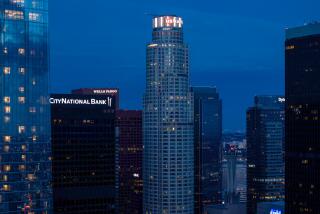Local bank a test case in rescue probe
- Share via
Can a $400-million injection of federal bailout money to the “bank to the stars” in Beverly Hills really help revive the troubled U.S. economy?
That’s one of the questions the Treasury Department’s inspector general is asking in a review of the decision to award bailout funds to City National Bank, The Times has learned.
The inspector general’s examination of the funding for City National reflects growing concern in Washington about whether the banking bailout is working. In a private meeting Dec. 10, top financial regulators, including Treasury Secretary Henry M. Paulson, acknowledged the difficulty of keeping track of the massive funding and measuring its effects on the economy, according to documents released Wednesday.
The inquiry is not based on any suspected wrongdoing by City National. Instead, investigators see the review as a case study into how the Treasury Department is implementing its controversial program to infuse $250 billion into the nation’s banking system and why certain institutions were selected to participate.
The program was launched at the peak of the financial crisis in October to strengthen banks and encourage them to lend money, thawing the freeze that has deepened the yearlong recession. But critics are questioning the effectiveness of the effort and whether bureaucrats can ensure that the money will actually be used to make loans.
So far, the Government Accountability Office and the Congressional Oversight Panel for Economic Stabilization have issued reports skeptical of the ability of the program to help the general economy and critical of the Treasury Department for not publicly explaining how it doles out taxpayer funds.
The new inquiry by Treasury Department Inspector General Eric Thorson takes a more focused examination of a single firm -- City National. The Beverly Hills institution is among 209 banks that have so far received a total of $162 billion in bailout money.
In a statement to The Times, the inspector general’s office said it wanted to know “specifically how financial institutions are determined to be eligible for participation” and that it was “looking at the application and selection of one institution based in Southern California.”
The statement, issued by Richard Delmar, counsel to the inspector general, did not name the bank. But City National was identified as the target of the inquiry in briefings on Capitol Hill last month, according to congressional officials who were not authorized to discuss the matter.
With more than $12 billion in deposits, City National is the largest bank based in Los Angeles County. It has long been known as the “bank to the stars” because it provides wealth-management services for entertainment industry figures. About 19% of its commercial loans go to the industry.
City National has said it was encouraged to apply for the bailout funds (which was first reported in late October as $395 million) and that there was no indication that it did anything wrong in seeking the money.
When the bank announced that it would get the funds, Chief Executive Russell Goldsmith said it would create a “fortress balance sheet that will reassure our clients and attract new clients.”
The inquiry has caught bank officials by surprise.
“We’re not aware of any such review,” spokeswoman Debora Vrana said. “As we’ve said before, the Treasury Department invested $400 million in City National as part of a broader plan to inject capital into some of the nation’s strongest financial institutions. This investment is a vote of confidence in City National.”
But experts outside the Bush administration are uncertain that the cash injections are helping the economy. The $250-billion banking bailout is the largest component of the $700-billion federal Troubled Asset Relief Program.
Richard H. Neiman, superintendent of banks for the state of New York and a member of the Congressional Oversight Panel that is probing the bailout, said nobody knew yet whether banks were hoarding the capital or using it to make loans.
A tension exists in the system now because banks fear the consequences of making bad loans in a recession, even while they are getting federal money and being exhorted to expand lending, Neiman said.
“It was a missed opportunity for the Treasury not to impose greater criteria and expectations to those banks receiving the funds, as well as greater reporting requirements to understand how the funds are being used,” he said.
It is also questionable whether the massive program is helping local communities. In mid-December, bankers, economists and business leaders in hard-hit Las Vegas told a hearing of the Congressional Oversight Panel that they had not seen any positive effect.
Treasury officials, however, have contended from the start that the program is intended to make healthy banks healthier.
“Our purpose is to increase confidence in our banks and increase the confidence of our banks, so that they will deploy, not horde their capital,” Secretary Paulson said in announcing the program Oct. 20. Since then, Treasury officials have pleaded for patience to allow the plan time to unfold.
The Treasury Department process for awarding the funds, however, seems opaque. Banks applying for the funds -- in some cases billions of dollars -- have only to fill out a two-page form.
Each bank request goes to the regulator for that segment of the industry, such as the Office of Thrift Supervision for savings and loans. A recommendation then goes to the Treasury Department’s Office of Financial Stabilization, and a closed-door committee decides who gets money. The 209 banks that have received funds are a tiny fraction of the roughly 8,000 banks in the nation.
Regulators have declined to say how many applications have been filed or the percentage that has been approved.
“The process is confidential,” said a spokesman for the Comptroller of the Currency, which regulates national banks.
Huge capital injections were made to Wells Fargo & Co., JPMorgan Chase & Co., Citigroup Inc. and Bank of America Corp., among many other household names. The controversial effort was intended to restore confidence in the banking system.
“People often ask: How do we know our program is working? First, we did not allow the financial system to collapse,” Neel Kashkari, chief of the Office of Financial Stabilization, told Congress on Dec. 10.
City National’s $400-million capital injection was the second largest among the 33 banks in California that have received funds through Dec. 22, according to the most recent Treasury transaction report. A total of $27.3 billion was given to California institutions, led by $25 billion for San Francisco-based Wells Fargo.
City National lacks a broad consumer banking network. The bank’s identification with wealthy clients, its headquarters in Beverly Hills and its association with an industry that is often viewed by outsiders as quirky may have played some part in why it was singled out for a review.
But its strong balance sheet exactly fits the profile of a bank that the Treasury Department wants to pour money into.
“We firmly believe that healthy banks of all sizes should use this program to continue making credit available in their communities,” Kashkari told a House committee in December.
In a televised interview last month, City National CEO Goldsmith said the federal program was cutting down on fear, and he criticized people who expected instant results.
“You don’t lend out $400 million in two weeks,” he told CNBC.
--
More to Read
Sign up for Essential California
The most important California stories and recommendations in your inbox every morning.
You may occasionally receive promotional content from the Los Angeles Times.














